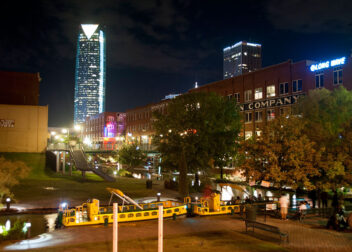Gavi Gangadhareshwara temple
The Gavi Gangadhareshwara temple is a famous Hindu temple located in Bangalore, India. It is dedicated to Lord Shiva and is known for its unique architecture and historical significance.
The temple is believed to have been built during the 9th century by the Western Ganga Dynasty, and later expanded and renovated by the Hoysala kings in the 13th century. The temple is carved out of a single stone and is renowned for its magnificent monolithic sculpture of Nandi, the sacred bull of Lord Shiva.
One of the most fascinating features of the Gavi Gangadhareshwara temple is the annual phenomenon that occurs on January 14th, known as the “Makar Sankranti.” During this time, the sun’s rays pass through a small window in the temple and illuminate the deity of Lord Shiva, creating a beautiful spectacle.
The temple is also known for its unique architectural features, including the intricately carved pillars, the beautiful ceiling adorned with sculptures, and the water channels that are believed to have been used for ablutions in ancient times.
The Gavi Gangadhareshwara temple is a popular pilgrimage site and attracts devotees from all over the country. It is an important cultural and historical landmark in Bangalore and is a must-visit for anyone interested in the rich history and cultural heritage of India.
History
The Gavi Gangadhareshwara temple has a rich and fascinating history that spans over several centuries. It is believed that the temple was built during the 9th century by the Western Ganga Dynasty, who ruled over the region that is now known as Karnataka.
The temple was initially a small cave temple that was dedicated to Lord Shiva. The temple was later expanded and renovated by the Hoysala kings in the 13th century. The Hoysalas were known for their love of architecture and art, and they added several new features to the temple, including the magnificent monolithic sculpture of Nandi, the sacred bull of Lord Shiva.
During the reign of the Vijayanagara Empire in the 16th century, the temple was further renovated and expanded. The Vijayanagara Empire was one of the most powerful empires in South India, and they made significant contributions to the temple’s architecture and art.
In the 18th century, the temple was invaded and damaged by the forces of Tipu Sultan, the ruler of the Kingdom of Mysore. Tipu Sultan was known for his military prowess, but he was also a patron of the arts and sciences. He later repaired the temple and restored it to its former glory.
Over the years, the Gavi Gangadhareshwara temple has undergone several renovations and restorations. Today, it stands as a testament to the rich cultural and architectural heritage of India and attracts visitors and pilgrims from all over the world.
Things to Must Know
If you’re planning to visit the Gavi Gangadhareshwara temple in Bangalore, India, there are a few things that you should know before you go. Here are some of the most important things to keep in mind:
- Dress Code: As with most Hindu temples in India, there is a dress code that visitors are expected to follow. Men should wear shirts and pants or traditional Indian attire, while women should wear sarees, salwar kameez, or other traditional Indian dresses that cover their shoulders and legs.
- Footwear: Visitors are not allowed to wear footwear inside the temple. There is a place outside the temple where you can leave your shoes or sandals, and it is recommended that you bring a pair of socks to wear while you’re inside.
- Photography: Photography is allowed inside the temple, but it is strictly forbidden to take photos of the deity. You can take photos of the architecture and other features of the temple, but it is important to be respectful and not disturb other visitors.
- Timings: The temple is open every day from 6:00 am to 8:30 pm. It is best to visit in the morning or evening, as the temple can get very crowded during the middle of the day.
- Festivals: The Gavi Gangadhareshwara temple is known for its annual festival, Makar Sankranti, which falls on January 14th. During this time, the sun’s rays pass through a small window in the temple and illuminate the deity of Lord Shiva, creating a beautiful spectacle.
- Puja: Visitors can participate in a puja (worship) at the temple. There are priests available who can perform a puja for you, or you can perform your own puja if you’re familiar with the customs and rituals.
- Accessibility: The temple is located in a hilly area, and there are several steps that you’ll need to climb to reach the temple entrance. While the temple is accessible to most visitors, it may not be suitable for people with mobility issues.
By keeping these things in mind, you can ensure that you have a safe and respectful visit to the Gavi Gangadhareshwara temple and make the most of your experience.
How to reach
The Gavi Gangadhareshwara temple is located in Bangalore, India, and can be easily reached by various modes of transportation. Here are some of the ways to reach the temple:
- By Road: The temple is located in the Gavipuram area of Bangalore, which is well-connected by road. You can take a taxi, auto-rickshaw, or public transport bus to reach the temple.
- By Metro: Bangalore has a metro system, and the nearest metro station to the temple is the National College Metro Station on the Green Line. From there, you can take a taxi or an auto-rickshaw to reach the temple, which is about 3 km away.
- By Train: Bangalore has several railway stations, and the nearest railway station to the temple is the Bangalore City Railway Station. From there, you can take a taxi, auto-rickshaw, or public transport bus to reach the temple, which is about 5 km away.
- By Air: Bangalore has an international airport, the Kempegowda International Airport, which is located about 40 km from the temple. From the airport, you can take a taxi or a bus to reach the temple.
It is advisable to use Google Maps or other navigation tools to ensure that you are taking the correct route and to avoid getting lost. It is also recommended to plan your visit during non-peak hours to avoid traffic congestion and crowds.
FAQ
Here are some frequently asked questions about the Gavi Gangadhareshwara temple:
- What is the significance of the Gavi Gangadhareshwara temple?
The Gavi Gangadhareshwara temple is a famous temple in Bangalore that is dedicated to Lord Shiva. It is known for its unique architecture, particularly the monolithic sculpture of Nandi, the sacred bull of Lord Shiva, and for the annual Makar Sankranti festival, during which the sun’s rays pass through a small window in the temple and illuminate the deity.
- What is the dress code for visiting the temple?
Visitors are expected to follow a dress code that is modest and respectful. Men should wear shirts and pants or traditional Indian attire, while women should wear sarees, salwar kameez, or other traditional Indian dresses that cover their shoulders and legs.
- Are non-Hindus allowed to visit the temple?
Yes, non-Hindus are allowed to visit the temple. However, visitors are expected to be respectful of the customs and rituals of the temple and to follow the dress code and other guidelines.
- What are the timings of the temple?
The temple is open every day from 6:00 am to 8:30 pm. It is best to visit in the morning or evening, as the temple can get very crowded during the middle of the day.
- Is photography allowed inside the temple?
Photography is allowed inside the temple, but it is strictly forbidden to take photos of the deity. Visitors can take photos of the architecture and other features of the temple, but it is important to be respectful and not disturb other visitors.
- Is there an entry fee for the temple?
No, there is no entry fee for the temple. However, donations are welcome and appreciated to support the maintenance and upkeep of the temple.
- Is the temple accessible to people with mobility issues?
The temple is located in a hilly area, and there are several steps that you’ll need to climb to reach the temple entrance. While the temple is accessible to most visitors, it may not be suitable for people with mobility issues.



